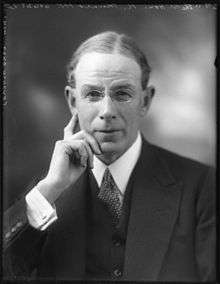Robert Munro, 1st Baron Alness
| The Right Honourable The Lord Alness GBE PC KC DL | |
|---|---|
 Robert Munro in 1922 | |
| Lord Advocate | |
|
In office 30 October 1913 – 5 December 1916 | |
| Monarch | George V |
| Prime Minister | H. H. Asquith |
| Preceded by | Alexander Ure |
| Succeeded by | James Avon Clyde |
| Secretary for Scotland | |
|
In office 10 December 1916 – 19 October 1922 | |
| Monarch | George V |
| Prime Minister | David Lloyd George |
| Preceded by | Harold Tennant |
| Succeeded by | The Viscount Novar |
| Lord Justice Clerk | |
|
In office 1922–1933 | |
| Monarch | George V |
| Preceded by | Lord Dickson |
| Succeeded by | Lord Aitchison |
| Personal details | |
| Born |
28 May 1868 Alness, Ross-shire |
| Died |
6 October 1955 (aged 87) Bournemouth, Hampshire |
| Nationality | Scottish |
| Political party |
Liberal Liberal National |
| Spouse(s) |
(1) Edith Evans (d. 1920) (2) Olga Grumler |
| Alma mater | University of Edinburgh |
Robert Munro, 1st Baron Alness, GBE, PC, QC, DL (28 May 1868 – 6 October 1955) was a Scottish lawyer, judge and Liberal politician. He served as Secretary for Scotland between 1916 and 1922 in David Lloyd George's coalition government and as Lord Justice Clerk between 1922 and 1933.
Background and education
Munro was born in Alness, Ross-shire, the son of Margaret (née Sinclair), daughter of Reverend John Sinclair, and Reverend Alexender Ross Munro. He was educated at Aberdeen Grammar School and the University of Edinburgh.[1]
Legal and political career
Munro was admitted to the Scottish Bar as an Advocate in 1893. He was a Counsel to the Board of Inland Revenue and became a King's Counsel in 1910.[1] At the January 1910 general election he was elected as a Liberal Member of Parliament for Wick Burghs, holding the seat until its abolition for the 1918 election.[1][2] He was then returned to the House of Commons as MP for the new Roxburgh and Selkirk constituency, holding the seat until 1922.[1][3]
In 1913 Munro was sworn of the Privy Council[4] and appointed Lord Advocate[5][6] by H. H. Asquith. When David Lloyd George became Prime Minister in December 1916, Munro entered the cabinet as Secretary for Scotland,[7] a post he held until the end of the coalition government in October 1922. The latter year he was appointed to the bench as Lord Justice Clerk and President of Second Division of the Court of Session,[8] taking the judicial title Lord Alness. He also held the office of Honourable Bencher, Lincoln's Inn in 1924.[1]
Following his retirement from the bench in 1933, he was raised to the peerage as Baron Alness, of Alness in the County of Ross and Cromarty, on 27 June 1934.[9] He returned to political office in May 1940 when Winston Churchill appointed him a Lord-in-waiting (government whip) in the newly formed war coalition,[10] sitting as a Liberal National. He retained this post (as one of few non-Conservatives) in Churchill's brief 1945 caretaker government. In 1947 he was invested as a Knight Grand Cross of the Order of the British Empire.[1]
Lord Alness was also a Deputy Lieutenant of Edinburgh.[1]
Personal life
Lord Alness was twice married. He married firstly Edith Gwladys, daughter of Reverend John Lewellyan Evans, in 1898. After her death in September 1920 he married secondly Olga Marie, daughter of Jeanes Georges Grumler, in 1921. Both marriages were childless. Lord Alness died in October 1955, aged 87, when the barony became extinct.[1]
References
- 1 2 3 4 5 6 7 8 thepeerage.com Robert Munro, 1st and last Baron Alness
- ↑ leighrayment.com House of Commons: West Lothian to Widnes
- ↑ leighrayment.com House of Commons: Rochester to Ryedale
- ↑ "No. 28783". The London Gazette. 19 December 1913. p. 9333.
- ↑ "No. 12613". The Edinburgh Gazette. 4 November 1913. p. 1143.
- ↑ "No. 28770". The London Gazette. 4 November 1913. p. 7676.
- ↑ "No. 29860". The London Gazette. 12 December 1916. p. 12118.
- ↑ "No. 32757". The London Gazette. 20 October 1922. p. 7369.
- ↑ "No. 34067". The London Gazette. 6 July 1934. p. 4334.
- ↑ "No. 34864". The London Gazette. 4 June 1940. p. 3351.
- Torrance, David, The Scottish Secretaries (Birlinn 2006)
External links
- Hansard 1803–2005: contributions in Parliament by Robert Munro
| Parliament of the United Kingdom | ||
|---|---|---|
| Preceded by Sir Arthur Bignold |
Member of Parliament for Wick Burghs January 1910–1918 |
Constituency abolished |
| New constituency | Member of Parliament for Roxburgh and Selkirk 1918–1922 |
Succeeded by Sir Thomas Henderson |
| Legal offices | ||
| Preceded by Alexander Ure |
Lord Advocate 1913–1916 |
Succeeded by James Avon Clyde |
| Preceded by Lord Dickson |
Lord Justice Clerk 1922–1933 |
Succeeded by Lord Aitchison |
| Political offices | ||
| Preceded by Harold Tennant |
Secretary for Scotland 1916–1922 |
Succeeded by The Viscount Novar |
| Peerage of the United Kingdom | ||
| New creation | Baron Alness 1934–1955 |
Extinct |
.svg.png)